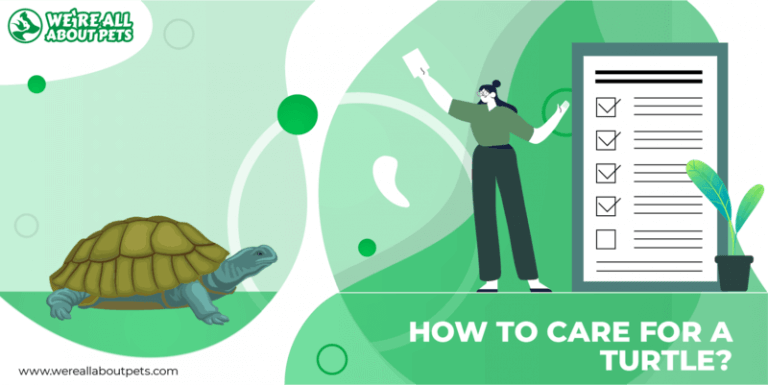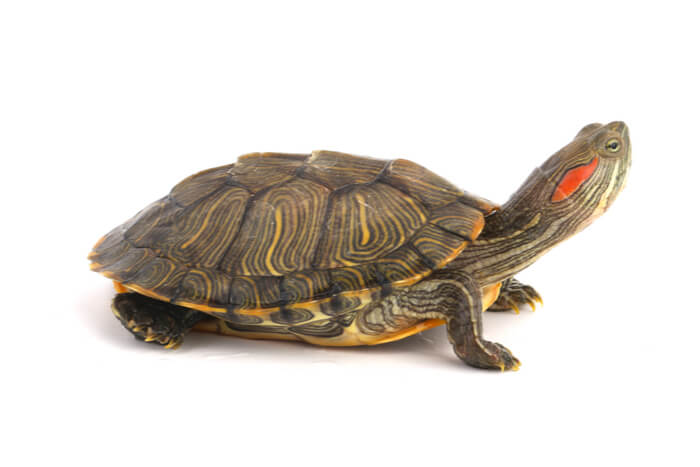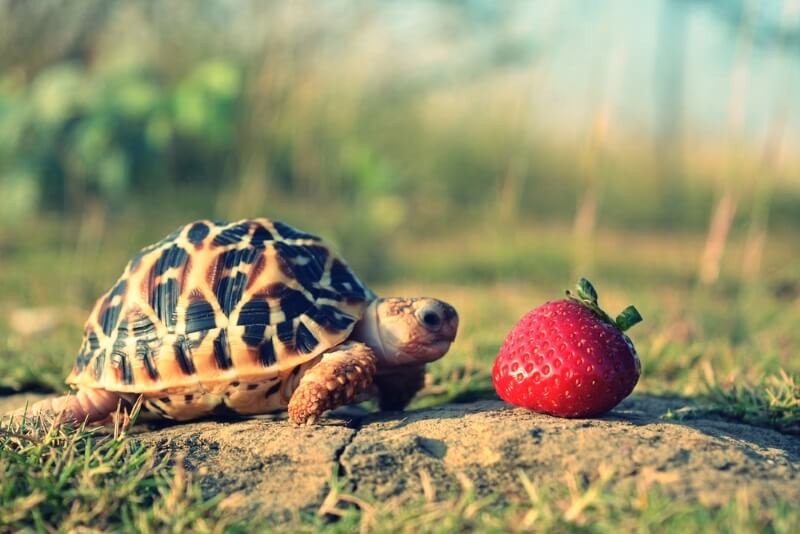How To Care For A Turtle
This page contains affiliate links. We may earn money or products from the companies mentioned in this post through our independently chosen links, which earn us a commission. Learn More
General Stats:
- Pet Type: Reptile
- Size: 5 to 11 inches
- Diet: Omnivore
- Lifespan: 20 to 40 years
When it comes to choosing a pet, many people go for traditional options like a dog or cat – maybe even a small furry pet like a hamster. If you’re looking for a pet that isn’t traditional, consider a turtle.
Pet turtles are unique and entertaining, but they aren’t for everyone. There are many different types of turtles and there are significant differences in caring for water turtles like painted turtles and land turtles like box turtles. You’ll need to do your research on pet turtle care before you make your choice.
To help you decide whether a pet turtle is the right choice for you, we’ve created a quick turtle care guide to cover the basics.
Here’s what you need to know about caring for a pet turtle.
Habitat Setup for Turtles
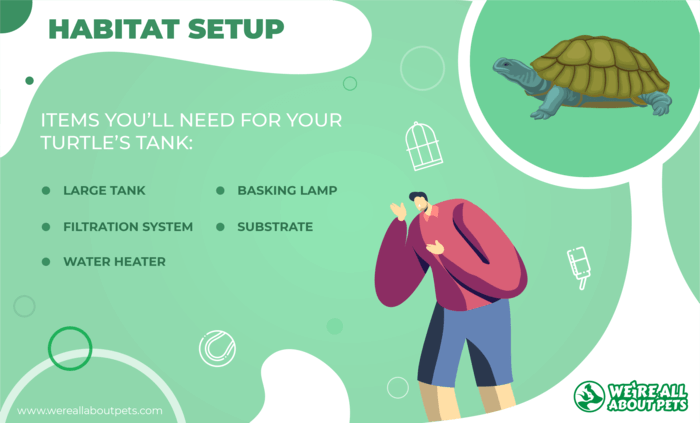
Setting up your turtle’s habitat is not a task you should take lightly. After all, your turtle will spend the majority of its life in this habitat, so it needs to meet his needs.
The most important thing to consider with your turtle’s cage is space.
Even smaller water turtles do best in tanks 100 gallons or larger. If you are raising a hatchling, you may be able to start with something smaller and upgrade later. Just remember, it is illegal to sell turtles smaller than 4 inches in the United States, so you’ll most likely only find adult turtles in the pet store.
Here are some of the items you’ll need for your turtle’s tank:
- Large Tank – Choose a tank larger than you think you need and make sure it is made from sturdy materials. A 4-inch turtle requires at least 20 but ideally 40 gallons or more.
- Filtration System – Aquatic turtles need clean water, so choose a high-quality filter system like a canister filter and make sure it is appropriately rated for the tank size you have. If the filter is designed for fish, it should be rated for 2-3 times the volume of water that you have for your turtle.
- Water Heater – The ideal temperature for your pet depends on the species of turtle, but you’ll probably need a water heater to maintain the right water temperature. Make sure the heater and cord are shielded to prevent burns from the heater and keep your turtle from chewing the cord.
- Basking Lamp – Even water turtles need a basking area, so look for a heat lamp that provides UVA and UVB rays. You may also want to position a piece of driftwood or rock under the lamp so your turtle can use it properly.
- Substrate – You don’t necessarily need substrate in the bottom of an aquatic turtle tank, but it may help keep things clean. Pebbles, sand, and coconut fiber are good options. The substrate should be large enough to prevent your turtle from swallowing it.
Aquatic turtles don’t require a water bowl or water bottle, but you should provide a water source for box turtles and other land turtles. A shallow dish cleaned daily should be sufficient.
Food bowls for turtles should be made from sturdy materials and shallow enough for the turtle to access easily.
Also Read: The Cost Of Owning A Turtle
Turtle Diet
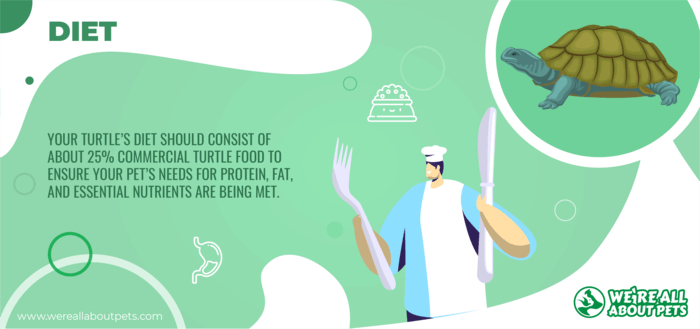
The most important thing to remember about your pet turtle’s diet is that most turtle species are omnivores while tortoises are strict vegetarians. The fact that your turtle is an omnivore means you’ll need to provide a variety of foods including insects, feeder fish, and vegetation.
The key to creating a healthy diet for your turtle is to mimic what that specific turtle species would eat in the wild. For aquatic turtles, fish may play a larger role in the natural diet while vegetation and insects might make up the majority of a land turtle’s diet.
Be aware that many fish have an enzyme that breaks down Vitamin B. If they’re fed only fish, then they may become sick from vitamin deficiency.
Here are some quick facts about the ideal turtle diet:
- Your turtle’s diet should consist of about 25% commercial turtle food to ensure your pet’s needs for protein, fat, and essential nutrients are being met.
- Provide your turtle with a combination of insects to supplement his needs for fat and protein – things like crickets, mealworms, and earthworms are good choices. Insects should have calcium supplements added for health.
- Offer small feeder fish or goldfish to your turtle as a good source of protein – just make sure they are from a reputable source or have been quarantined to make sure they aren’t sick.
- Supplement your turtle’s diet with fresh foods like leafy greens and veggies. Turtles enjoy things like kale, collard greens, romaine lettuce, carrot tops, etc.
In addition to food, be sure to provide your pet with unlimited access to fresh water as well. A water bowl should be provided. It should be large enough for the turtle to soak. Just be sure to clean it and refill it on a daily basis.
Also Read: What Do Turtles Eat?
Turtle Veterinary Care
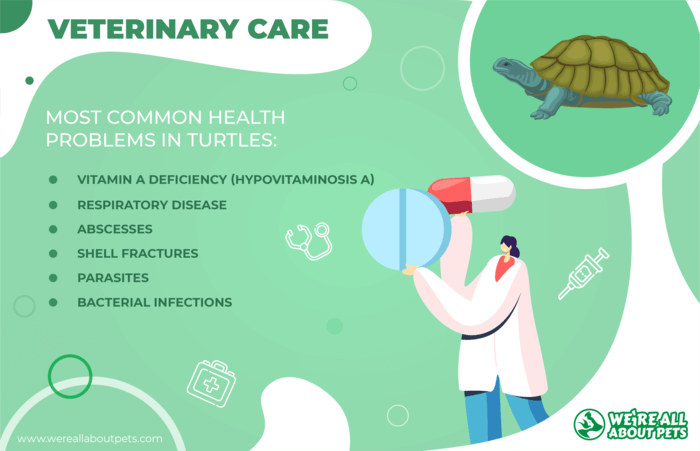
If you care for your pet turtle properly, you can enjoy his company for 20 years or more.
The key is to do your research ahead of time so you understand the responsibility and so you can provide for your pet’s needs. This includes both a healthy diet and a suitable habitat. You should also educate yourself about potential health problems, so you know what to look out for.
Here are some of the most common health problems in turtles:
- Vitamin A deficiency (hypovitaminosis A)
- Respiratory disease
- Abscesses
- Shell fractures
- Parasites
- Bacterial infections
The best way to prevent health problems in turtles is to feed your pet a healthy diet.
A balanced diet will provide for your turtle’s nutritional needs, keeping him strong and healthy so he can live out his full life span. You should still seek routine veterinary care in the form of an annual check-up, but turtles don’t require any vaccinations or ongoing treatment for the most part.
Keep in mind that most vets aren’t trained to treat reptiles and exotic pets, so you may need to do some research to find a vet in your area that will see your pet turtles. You may also want to put aside some money in savings to cover the cost of emergency care.
A good place to start your search is https://arav.site-ym.com/search/custom.asp?id=3661.
Pet insurance plans are tempting but you may have trouble finding one that covers turtles and, if you do, the cost of the premium may not be worth the value you’d receive in benefits.
Turtle Fun Facts
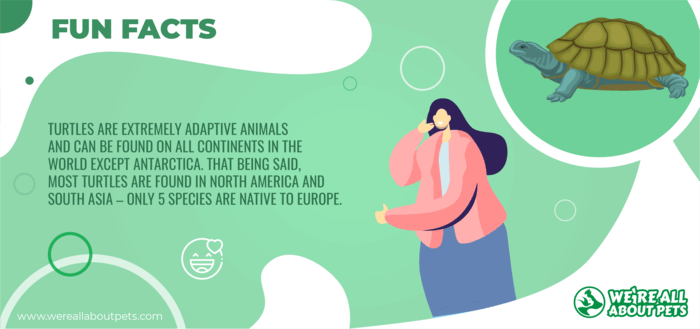
- Turtles are extremely adaptive animals and can be found on all continents in the world except Antarctica. That being said, most turtles are found in North America and South Asia – only 5 species are native to Europe.
- The turtle belongs to one of the oldest groups of reptiles in the world – they are even older than crocodiles, alligators, and snakes. Their evolution dates back to the time of the dinosaurs, over 200 million years.
- Turtles do not bear live young but lay eggs. When a female turtle is carrying eggs, she is said to be gravid rather than pregnant and she will most likely need to expel the eggs even if they haven’t been fertilized – if she doesn’t, there’s a risk she may become “egg bound.”
- The turtle is easy to recognize by its bony shell that acts as a shield to protect the turtle’s vulnerable internal organs from predators – some turtles can tuck their heads into the shell.
- A turtle’s shell is actually part of its skeleton, made up over 50 bones which includes the rib cage and spine – a turtle cannot separate its body from its shell because they are one and the same.
- There is no average turtle size because it ranges so significantly from one species to another. The largest species of sea turtle is the leatherback, weighing 600 to 1,500 pounds while the largest freshwater turtle is the alligator snapping turtle, weighing up to 200 pounds.
- Turtles are largely omnivorous by nature, but many start out carnivorous. Baby turtles feed primarily on fish, insects, and crustaceans but grow to eat more vegetation as they mature.
If you’re considering a non-traditional pet, the turtle might be one to consider. These reptiles are quite unique and can be very entertaining, but they can be a bit of a challenge.
Do your research ahead of time on aquatic turtle care or start off a little easier with a land turtle.
Frequently Asked Questions
How long do turtles live?
The average life span for a pet turtle may vary depending on the species, but you should expect your pet turtle to live for at least 20 years with proper care.
How much do turtles cost?
Generally speaking, you can expect proper care of a turtle to cost more than care for a small animal like a hamster or gerbil. The cost to keep a pet turtle depends on the type of turtle you choose and the required setup. Aquatic turtles require large tanks with a filtration system and water heater while land turtles may only require a basking area and source of UVA and UVB rays. The cost to purchase a turtle may range from $10 to $100 but you could easily spend $200 to $800 on the setup alone.
How big do turtles get?
There are many different types of turtles, so a turtle’s adult size depends on the species. Common aquatic turtles like red-eared slider turtles grow up to 16 inches long, though the average size is usually between 6 and 8 inches. Land turtles like box turtles may be entirely different. The average size for a box turtle is only about 4.5 to 6 inches.
What do turtles eat?
Turtles are omnivores by nature while tortoises are strict vegetarians. Dietary specifics vary from one type of turtle to another, but most turtles eat a combination of insects, fish, crustaceans, and vegetation. Pet turtles may also eat commercial turtle pellets.
Are turtles good pets?
Whether turtles make good pets depends on your interest in them and how much work you’re willing to do. A pet turtle is a long-term commitment, as these reptiles have the capacity to live 20 years or more. When it comes to the care of a turtle, you’ll need to provide plenty of space and a balanced diet. There’s also the concern of veterinary care, should it be required. Turtles can be very interesting and educational pets, but they do take a lot of work.
Where do turtles come from?
Different species of turtle come from different areas. Turtles can be found on every continent except Antarctica in both aquatic and terrestrial environments.
Do turtles bite?
Unlike dogs and cats, turtles are not domesticated so they are less likely to bond with their human caretakers. It’s difficult to make general statements about whether turtles bite because it depends on the situation. Turtles generally don’t like to be handled, however, so if you handle your turtle there is some risk of being bitten.
Do turtles sleep?
Yes, turtles sleep just like other animals. In addition, some turtles will hibernate or brumate in certain seasons. This is a period of time when their metabolism will slow down, reducing the need for food. They may go for several months with little to no food during this time. They may also slow their heart rate and breathing rate significantly. This can look the same as a sick turtle, so veterinary advice should always be sought out to make sure it’s not masking another illness.
How long are turtles pregnant for?
As reptiles, turtles lay eggs rather than giving birth to live young. All healthy female adult turtles produce eggs and, when carrying eggs, she is said to be gravid rather than pregnant. While many amphibians can absorb unfertilized eggs into their bodies, most turtles can’t so they must expel them.






